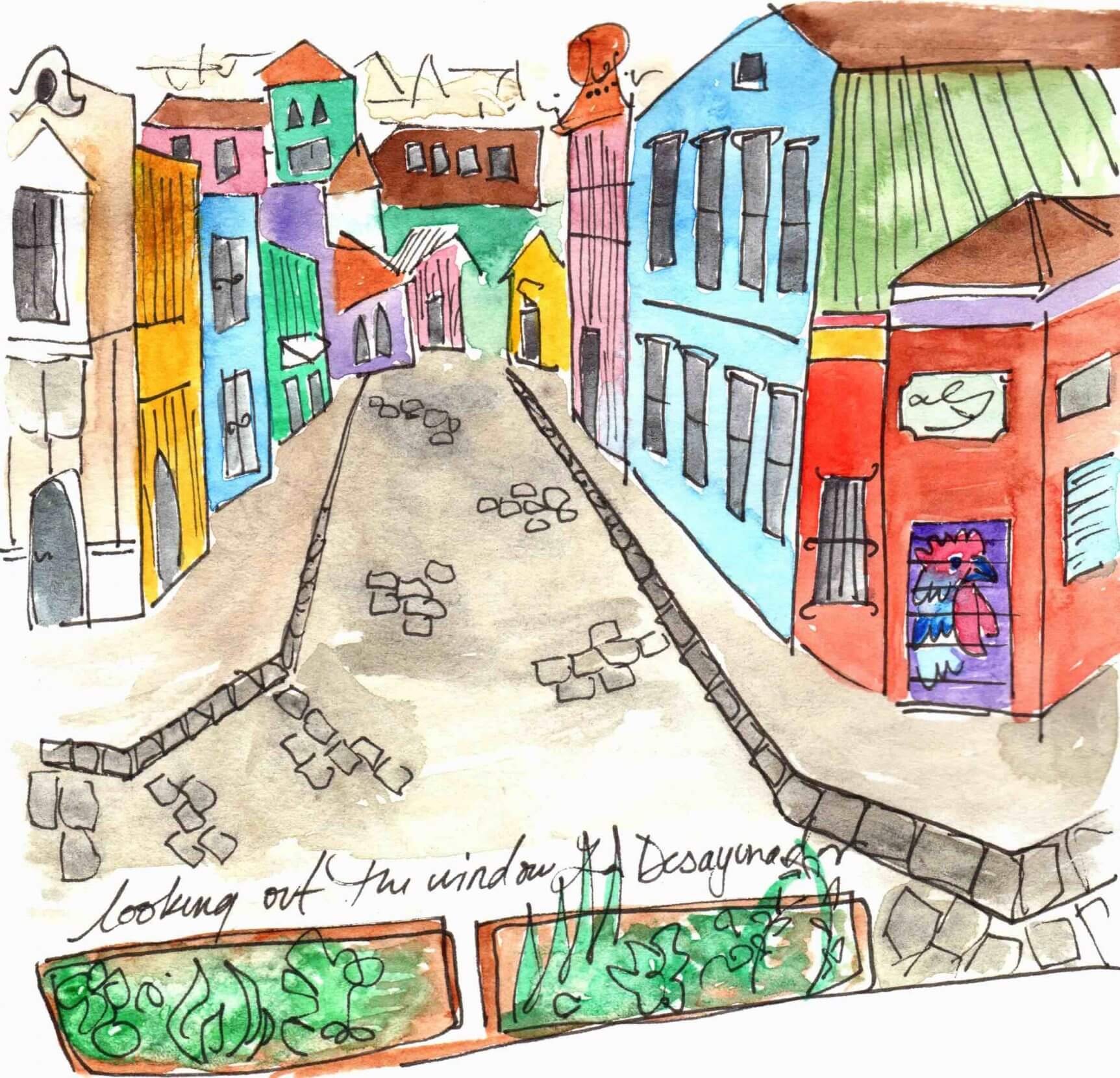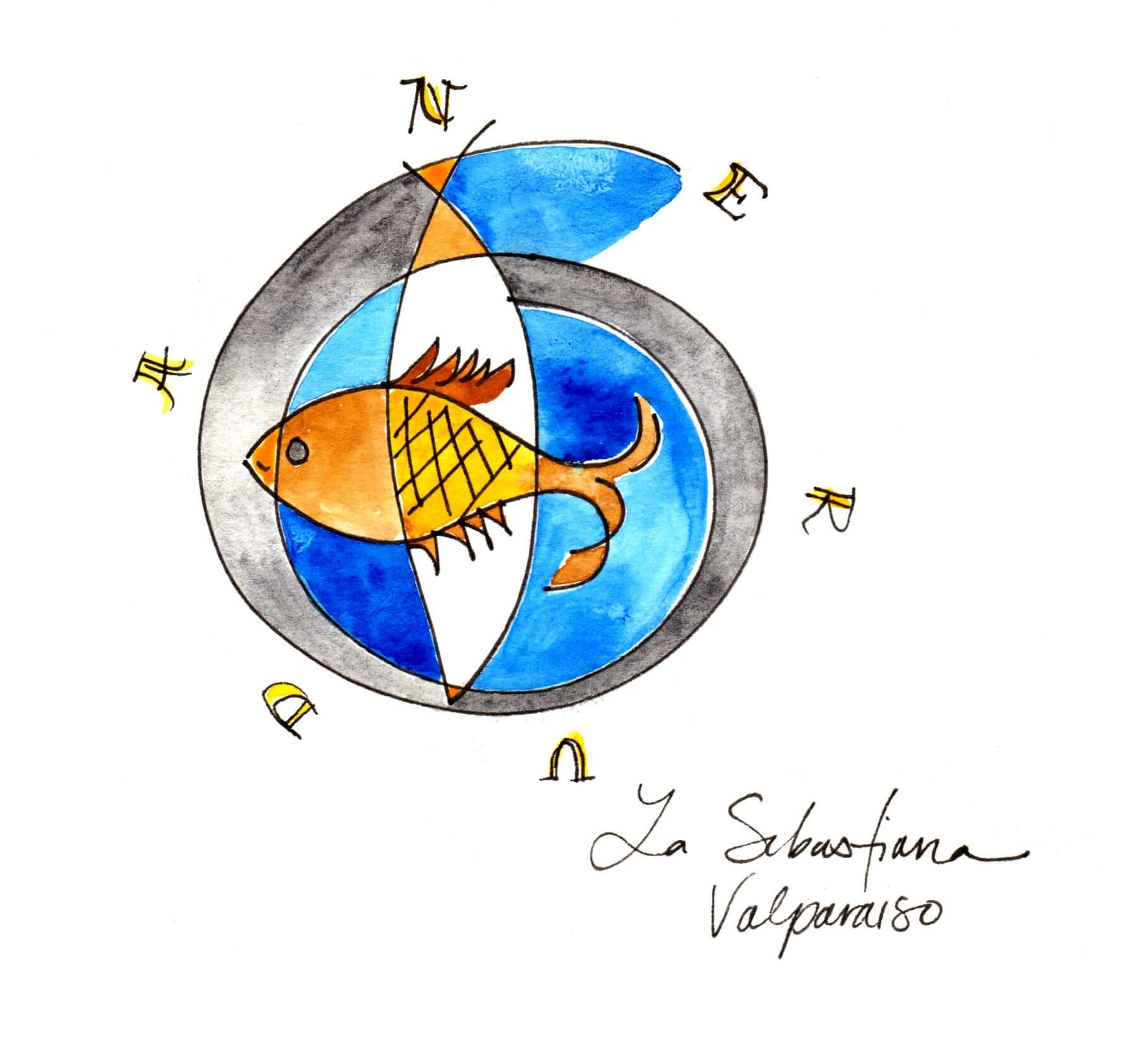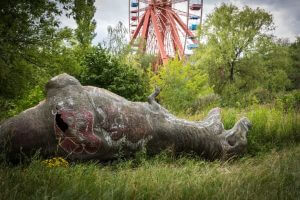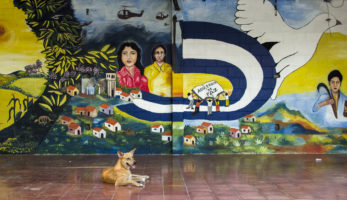Support Hidden Compass
Our articles are crafted by humans (not generative AI). Support Team Human with a contribution!

Cerro Alegre by author Anna Elkins. Painting: Anna Elkins.
How a poem is born on a pilgrimage to Pablo Neruda’s homeland
[The poet’s] raw material consists of elements that are and at the same time are not, of things that exist and do not exist. -Pablo Neruda, Memoirs
He celebrated lemons, socks, artichokes, bees, broken things. He could look at a tuna in the market and see the truth of the sea in it. He filled his odes with clocks and memory, thread and temptation, wine and dreams. He let the visible introduce the Invisible.
He invited readers to see.
I took the invitation a bit further. I have come to Chile, The Poet’s birthplace, to check out his raw material and the houses where he lived.
It’s early evening, and I am sitting on the balcony of a sooty, high-rise apartment building in Santiago, with a goblet of Carménère in one hand and my iPad in the other. A pixelated video plays an old song: “Si Vas Para Chile.” English subtitles tell me how the Chileans will emerge from their little houses to welcome the forastero — the sojourner.
The song was written about a century ago. And a century ago, it was quite a feat to get to this lanky country: whether overland or over sea. Sojourners would have either crossed the craggy Andes on Chile’s eastern side, or sailed the Pacific that lines her entire west — all four thousand miles of her.

Viña del Mar by author Anna Elkins Painting: Anna Elkins.
I flew in conveniently by plane. Despite my modern transport, I hope my poetry pilgrimage is still valid. And I am curious: Will I feel some sense of home in Neruda’s homeland?
I am trying to answer that question by visiting all three of The Poet’s Chilean houses — La Chascona, La Sebastiana, and Isla Negra.
Yesterday, I visited the house in Santiago — La Chascona — delighting at the jewel-hued glass goblets Neruda used to serve red wine to guests.
Similar goblets line the shelves of the dining room where I’m staying, and I am drinking from one the color of cobalt. I hold it up to the evening light and the shadowed city. An early-winter haze fills the sky gaps between buildings with a murky gray, illuminated by the ruby glow of an invisible setting sun.
Forastero. I want to know more. I toast the sun I wish I could see and open an online dictionary. It tells me that forastero means “strange.” That makes sense: like stranger.
Another dictionary gives me some etymology: “from Catalan, foraster … from Old Provençal, forestier, from forest, hamlet, country house …”
That explains even the little house in the song from the video.
I look beyond the balcony railing. No little houses — just high-rises. No forest, either. Below me, traffic on Avenida Presidente Riesco is going east. The street is a via reversible. Weekday mornings, traffic goes west. Afternoons and evenings: east. And at night and weekends, it’s two-way traffic.
I begin to write to consistent sounds of passage:
Here, in a forest of buildings so thick
you can’t see a whole cloud,
I hunt the poet who haunts me.
You, traveler of world and word,
were you a forastero in your own land?
I close my eyes. The only answer I hear is traffic.
It is time to head for the sea.
~~
I take a bus to the coastal town of Valparaiso. Dozens of cerros — hills — rise up from the port. Some of the hills are UNESCO World Heritage sites, and I’m staying on one. Houses here are painted turquoise, magenta, cerulean, lime, cadmium.
I step out of my periwinkle bed and breakfast onto Calle Tempelman, a steep street prowled by barking dogs half a block downhill. This is no multi-lane thoroughfare like the one in front of the Santiago apartment. In fact, this street has turned into a kind of Technicolor garden: Concrete staircases line each side of a cobblestone road so rough, vehicles are no longer permitted. In the cavities between the old stones, flowers grow — their mild palette outdone by that of the wild house façades and the ground-level graffiti adding punches of neon.
I am stepping into a rainbow. To the soundtrack of barking and … the ocean? No, that would be distant traffic. The port is too far down the hills to hear.
I decide to go up the street instead of down, to avoid the dogs. Despite being already high up the cerro, I keep climbing up and up. I finally reach a road that levels out and traverses the hills.
Without realizing it, I am on my way to La Sebastiana, another of The Poet’s homes. When I arrive, I recognize the logo of La Fundación Pablo Neruda: a fish encircled by an astrolabe. I take the self-guided audio tour, listening to stories of Pablo’s life. He said his houses were his toys, and he filled them with toys, and he played in them all day long.
Like this town, the house is steep: five stories anchored into the hillside. Halfway up, I stop in front of a portrait of a queen. A wooden chest sits in attendance beneath her. Inside it, Pablo kept his best whiskey. Across from the queen, he hung a portrait of some nobleman — so the royalty wouldn’t grow lonely. At the foot of his “Cloud Chair” sits a white leather ottoman, stained with the green ink he used to write — the same green as the glass goblets on the dining room table here — gleaming electric emerald in the sunshine. The Poet said that even water tasted better in colored glass.
This makes me thirsty. I finish the tour, head out into the courtyard, and sit at one of the two tables outside the tiny, garden café. I order a cortado — Chile’s version of the breve: equal parts coffee and cream. I start sketching the astrolabe logo. The letters of Pablo’s last name wrap around the outer circle, like expanded points of a compass. I add a few swaths of watercolor. The matron brings my coffee and stands at my elbow, surveying the sketch. She touches it, leaving blue fingerprints as she pokes each letter, explaining the acronym of The Poet’s surname: N: Nosotros E: Estamos R: Rodeados U: Unicamente D: De A: Agua. “We are surrounded only by water.”
She nods and leaves. As the paint dries, I start writing:
You — dead before I was born,
but living on the page
living on
in your houses
where strangers come
to visit you.
–
Your life is a goblet
we drink words from.
A sea of words
that swallows us whole.
–
You leave hints
like stars for us to follow.
You traced a way
across the waters
of body and spirit.
~~
I travel to Isla Negra. The last of Pablo’s houses. It’s about an hour down the coast from Valparaiso, and here, the Pacific is free to make its salty noise against black rocks. For once, I hear only the traffic of raucous water.
Carved on a dark beam above the house’s front door are the words: “I returned from my travels. I navigate by building happiness.”
Pablo bought and added on to this house, turning it into a series of structures that line the sea — long like this country. It’s the only one of his houses that runs horizontally instead of vertically. Walking through it is like walking a path — from the figurehead-filled salon, through the library lined with pinned beetles and butterflies, to his office, overlooking the ocean.
I stand next to his writing table: a piece of driftwood brought by the sea to the rocks below. Pablo had it installed by the window.
Which odes did he write here?
Which wonders crossed his spirit?
Other visitors flow in and out. I resist the urge to cross the rope and sit in his chair. I finally ask myself: Do I feel any sense of home here?
A bee hits the outer windowpane with a glassy thud. No, I don’t feel like I am home. But I do feel like a kindred sojourner. A forastero — forastera.
Even through the windows, I hear the sea — that widest street, widest way. I step outside to hear it fully. I circle around the grounds. In one of the courtyards stands a sculpture of the foundation logo — the fish at the heart of an astrolabe. Fish out of water … is that implied?

Fundación Pablo Neruda by author Anna Elkins. Painting: Anna Elkins.
Neruda called himself a land captain. He got seasick and hated being on the water. But near it, yes. His kind of voyage was to landlock a sailboat into the garden outside his bar and sip wine in it with friends. Though he avoided traveling on the sea that surrounded him, he lived alongside it — sojourned across it with words.
I climb down past the boat, to the stone dais where The Poet is buried along the coastline. My shadow stretches beyond the rocks — toward the ocean he knew as friend and stranger.
ODE TO THE FORASTERO
And then I found you.
I don’t know where you came from —
from winter or an ocean.
—
I stood on your grave
by the waves, listening
for your bees and broken things.
You live on the page,
live on
in your houses
where strangers come
to visit you.
–
Your life is a goblet
we drink words from.
A sea of words
that swallows us whole,
turns us into kings and queens
in this long land
kissed constantly
by water.
–
Before, in a forest of buildings so thick
I couldn’t see a whole cloud,
I first hunted you who haunts me.
I did not find you there.
–
Again, on a steep hill in a steep house,
I looked for you.
I found the ink you spilled,
but I did not find you there.
–
You, traveler of world and word,
were you a forastero in your own land?
–
You left hints and hooks —
compass points
for fish out of water
to follow.
–
You summoned me from other streets.
And then I found you — here,
in this house by the sea.
–
The sea — noisy stranger —
bringing tables, people, stanzas
to your salt-licked door.
The sea — a via reversible,
going the way of the moon,
of the rocks,
of the heart.
–
Thank you
for coming out of your house
to welcome me
surrounded
only by water.
–
Thank you
for listening with me
for an eternity,
navigating happiness.
Anna Elkins
Anna Elkins is a traveling poet and painter who has lived in the shadows of the Rockies and the Alps, and on the shores of the Caribbean and Micronesian seas.



